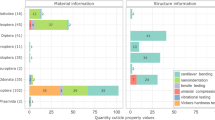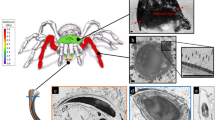Abstract
Insects have more than a million described species and represent more than half of all known living organisms. However, little is known about the operation and functions of the insect body, particularly their remarkable leg joints. This study is focused on partly filling this knowledge gap by using nanoindentation instruments to characterize the mechanical properties of leg joints from three different insects: a beetle, a mantis, and a dragonfly nymph. For all insect species, the tibia joint had the largest effective elastic moduli, followed by the femur joint, while the exocuticle had the smallest values.



Similar content being viewed by others
References
S. Kim, C. Laschi, and B. Trimmer: Soft robotics: a bioinspired evolution in robotics. Trends Biotechnol. 31, 287–294 (2013).
J.B. Puthoff, M. Holbrook, M.J. Wilkinson, K. Jin, N.S. Pesika, and K. Autumn: Dynamic friction in natural and synthetic gecko setal arrays. Soft Matter 9, 4855–4863 (2013).
U.G.K. Wegst, H. Bai, E. Saiz, A.P. Tomsia, and R.O. Ritchie: Bioinspired structural materials. Nat. Mater. 14, 23–36 (2015).
B. Bhushan: Bioinspired structured surfaces. Langmuir 28, 1698–1714 (2012).
J.K. Oh, S.T. Behmer, R. Marquess, C. Yegin, E.A. Scholar, and M. Akbulut: Structural, tribological, and mechanical properties of the hind leg joint of a jumping insect: using katydids to inform bioinspired lubrication systems. Acta Biomater. 62, 284–292 (2017).
B. Ji and H. Gao: Mechanical properties of nanostructure of biological materials. J. Mech. Phys. Solids 52, 1963–1990 (2004).
J. Meng, P. Zhang, and S. Wang: Recent progress of abrasion-resistant materials: learning from nature. Chem. Soc. Rev. 45, 237–251 (2016).
R. Rakitov and S.N. Gorb: Brochosomal coats turn leafhopper (Insecta, Hemiptera, Cicadellidae) integument to superhydrophobic state. Proc. R. Soc. B Biol. Sci. 280, 20122391 (2012).
J. Bustamante, J.F. Panzarino, T.J. Rupert, and C. Loudon: Forces to pierce cuticle of tarsi and material properties determined by nanoindentation: the Achilles’ heel of bed bugs. Biol. Open 6, 1541–1551 (2017).
Y. Zhang, H. Huang, J.X. Zhang, S.B. Zhang, and L.Q. Ren: Forces to pierce cuticle of tarsi and material properties determined by nanoindentation: the Achilles’ heel of bed bugs. Biol. Open 6, 1541–1551 (2017).
Y.H. Chen, M. Skote, Y. Zhao, and W.M. Huang: Stiffness evaluation of the leading edge of the dragonfly wing via laser vibrometer. Mater. Lett. 97, 166–168 (2013).
J.K. Oh, C. Yegin, and M. Akbulut: Micro/nanoscale tribological and mechanical investigation of the articular surfaces of katydid leg joints: potential for the novel bioinspired lubrication systems. MRS Adv. 2, 1117–1123 (2017).
B.A. Kheireddin, T.C. Williams, and M. Akbulut: Tribological properties of femur-tibia articulation of lubber grasshopper. Tribol. Int. 50, 76–81 (2012).
M. Burrows: Froghopper insects leap to new heights. Nature 424, 509–509 (2003).
M.A. Meyers, P.-Y. Chen, A.Y-M. Lin, and Y. Seki: Friction and wear properties of the tergum surface of mole cricket Gryllotalpa orientalis. Appl. Mech. Mater. 461, 707–711 (2013).
N. Barbakadze: Local mechanical properties of the head articulation cuticle in the beetle Pachnoda marginata (Coleoptera, Scarabaeidae). J. Exp. Biol. 209, 722–730 (2006).
J. Sun, W. Wu, M. Ling, B. Bhushan, and J. Tong: A dynamic nanoindentation technique to investigate the nanomechanical properties of a colored beetle. RSC Adv. 6, 79106–79113 (2016).
S.S. Singh, M.A. Jansen, N.M. Franz, and N. Chawla: Microstructure and nanoindentation of the rostrum of Curculio longinasus Chittenden, 1927 (Coleoptera: Curculionidae). Mater. Charact. 118, 206–211 (2016).
Acknowledgments
This material is based upon the work supported by the National Science Foundation under Grant No. 1434421 to J.K. Oh and M. Akbulut.
Author information
Authors and Affiliations
Corresponding authors
Rights and permissions
About this article
Cite this article
Oh, J.K., Behmer, S.T., Marquess, R. et al. Investigation of mechanical properties of tibia and femur articulations of insect joints with different joint functions. MRS Communications 9, 900–903 (2019). https://doi.org/10.1557/mrc.2019.71
Received:
Accepted:
Published:
Issue Date:
DOI: https://doi.org/10.1557/mrc.2019.71




